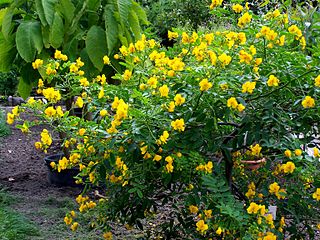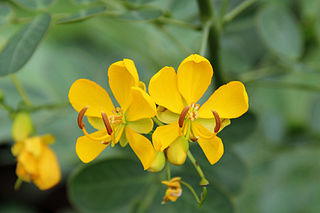
Cassia is a genus of flowering plants in the legume family, Fabaceae, and the subfamily Caesalpinioideae. Species are known commonly as cassias. Cassia is also the English common name of some species in the genus Cinnamomum of the family Lauraceae. Species of the genera Senna and Chamaecrista were previously included in Cassia. Cassia now generally includes the largest species of the legume subtribe Cassiinae, usually mid-sized trees.

Dipteryx is a genus containing a number of species of large trees and possibly shrubs. It belongs to the "papilionoid" subfamily – Faboideae – of the family Fabaceae. This genus is native to South and Central America and the Caribbean. Formerly, the related genus Taralea was included in Dipteryx.

Senna obtusifolia, known by the common names Chinese senna, American sicklepod, sicklepod, etc., is a plant in the genus Senna, sometimes separated in the monotypic genus Diallobus. It grows wild in North, Central, and South America, Asia, Africa, and Oceania, and is considered a particularly serious weed in many places. It has a long-standing history of confusion with Senna tora and that taxon in many sources actually refers to the present species.

Senna tora is a plant species in the family Fabaceae and the subfamily Caesalpinioideae. Its name is derived from its Sinhala name tora (තෝර). It grows wild in most of the tropics and is considered a weed in many places. Its native range is in Central America. Its most common English name is sickle senna or sickle wild sensitive-plant. Other common names include sickle pod, tora, coffee pod and foetid cassia. It is often confused with Chinese senna or sicklepod, Senna obtusifolia.

Senna corymbosa is an ornamental plant in the genus Senna. It is also known as Argentine senna, Argentina senna, buttercup bush, flowering senna, Texas flowery senna or tree senna.

Senna alexandrina is an ornamental plant in the genus Senna. It is used in herbalism. It grows natively in upper Egypt, especially in the Nubian region, and near Khartoum (Sudan), where it is cultivated commercially. It is also grown elsewhere, notably in India and Somalia.

Senna artemisioides, the wormwood senna, is a species of flowering plant in the pea family Fabaceae. It is endemic to Australia, where it is found in all mainland states and territories. Other common names include silver senna, silver cassia or feathery cassia - although "cassia" generally refers to the largest-growing Cassiinae. Some of its distinct subspecies also have common names of their own.
Albizia berteriana, the Bertero albizia, is a species of plant in the family Fabaceae. It is found in Cuba, the Dominican Republic, Haiti, and Jamaica.
Albizia pistaciifolia is a species of plant in the family Fabaceae. It is found in Colombia, Ecuador, and Venezuela.
Hesperalbizia occidentalis is a species of plant in the family Fabaceae. As a native plant it is found only in Mexico, where it is endangered by deforestation. It has been introduced to Honduras.
Abarema acreana is a tree species in the legume family (Fabaceae). It is a rather mysterious plant and may be endemic to Brazil. Fruiting trees apparently have never been found, and thus it is not clear whether this plant belongs into the genus Abarema, or in Hydrochorea, or elsewhere.
Chloroleucon foliolosum is a tree species in the legume family (Fabaceae). It is found in Argentina, Brazil and Bolivia.
Pithecellobium pithecolobioides, known as Granadillo de Río, is a tree species in the legume family (Fabaceae).
Abarema glauca, the glaucous abarema, is a tree species in the legume family (Fabaceae). It is found in Cuba, Dominican Republic, and Venezuela. Common rural names are: caracolí, nijaguao, paují (Pittier), jijaguao, and merey montañero (Hoyos). Abarema glauca is found most easily on the east coast of Dominican Republic, in Uvero Alto, north of Punta Cana..
Zygia cognata is a tree species in the legume family (Fabaceae). It is found in Belize, Guatemala, and Honduras.
Pseudosamanea cubana is a tree species in the legume family (Fabaceae). It is found only in Cuba.

Archidendron bigeminum is a tree species in the legume family (Fabaceae). It is found in India and Sri Lanka. It is known as "kalitiya - කලටිය" in Sinhala.

Pterocarpus santalinoides is a tree species in the legume family (biology) (Fabaceae); it is locally known as mututi.

Senna bicapsularis is a species of the legume genus Senna, native to northern South America, from Panama south to Venezuela and Colombia, and also the West Indies. Common names include rambling senna, winter cassia, Christmas bush, money bush, and yellow candlewood. In Florida, Senna pendula is usually cultivated as, and misapplied to, S. bicapsularis.
Senna wislizeni, commonly called Wislizenus' senna or shrubby senna. Formerly in the "wastebin taxon" Cassia sensu lato, it is now placed in the genus Senna or sometimes separated in Palmerocassia together with Senna unijuga.










